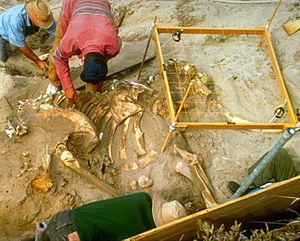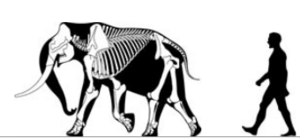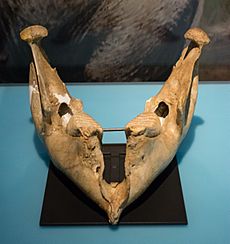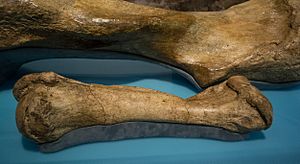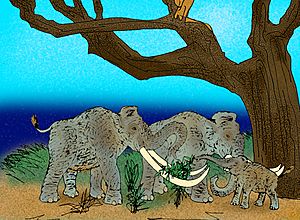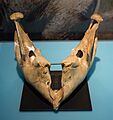Pygmy mammoth facts for kids
Quick facts for kids Pygmy mammoth |
|
|---|---|
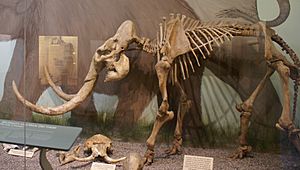 |
|
| Skeleton | |
| Scientific classification | |
| Genus: |
Mammuthus
|
| Species: |
exilis
|
The pygmy mammoth or Channel Islands mammoth (Mammuthus exilis) was an extinct type of dwarf elephant. It came from the much larger Columbian mammoth (M. columbi) that lived on mainland North America.
This amazing animal became extinct during a time called the Quaternary extinction event. Many large animals, known as megafauna, died out then. This happened because the world's conditions changed, and these animals could not adapt.
The pygmy mammoth is a great example of island dwarfism. This means animals on islands sometimes evolve to become much smaller. In 2010, scientists found that M. exilis was about 1.72 meters (5.6 ft) tall at the shoulder. It weighed around 760 kilograms (1,680 lb). This is tiny compared to its ancestor, the Columbian mammoth. The Columbian mammoth was about 4.3 meters (14 ft) tall and weighed 9,070 kilograms (20,000 lb)! Other estimates suggest the pygmy mammoth was about 2.02 meters (6.6 ft) tall and weighed 1,350 kilograms (2,980 lb).
Contents
Discovering the Pygmy Mammoth
People have known about mammoth bones on California's northern Channel Islands since 1856. Scientists first wrote about them in 1873.
In 1994, the National Park Service asked scientists to check out a skeleton. It was found on the northeast coast of Santa Rosa Island. They found bones from a large animal's main body. So, they decided to dig up the whole skeleton.
They found almost all of a male pygmy mammoth's skeleton. It was about 50 years old when it died. The small bones were still in their original positions. This showed that the mammoth died right where it was found. It had not been moved around the island. The bones were then taken to the Santa Barbara Museum of Natural History.
After this discovery, a search was done across the island. This led to finding 160 new places with mammoth remains. Most of these were on Santa Rosa Island. This 1994 find was the first time a nearly complete pygmy mammoth skeleton was discovered. Luckily, only one foot, a tusk, and a few backbones were missing. Sand dunes had covered the remains, keeping the bones together.
Where Did Pygmy Mammoths Live?
Since 1856, pygmy mammoth bones have been found on three northern Channel Islands of California. These are Santa Cruz, Santa Rosa, and San Miguel. These islands, along with Anacapa, were once part of a much larger "superisland" called Santa Rosae. Most of Santa Rosae is now under water.
These elephants lived on the islands until humans arrived about 13,000 years ago. The last known pygmy mammoths lived around 13,000 to 12,900 years ago. This was before the Chumash people arrived in the early Holocene period. That was between 10,800 and 11,300 years ago. Radiocarbon dating shows that M. exilis lived on the island for at least 47,000 years.
Modern elephants are excellent swimmers. The ancestors of M. exilis likely swam the 4 kilometers (2.5 mi) to Santa Rosae. As the number of mammoths grew, there were fewer large predators like the dire wolf, Smilodon (saber-toothed cat), and the American lion. Also, sea levels rose at the end of the ice age. This caused Santa Rosae to split into four smaller islands. This favored smaller animals.
Because of this, pygmy mammoths started to evolve. Their bodies became smaller over generations. This was a way to survive on the shrinking Santa Rosa Island. Smaller bodies needed less food and resources to stay alive. After this long period of change, the mammoth became a new species: the pygmy mammoth.
It's important not to confuse M. exilis with mammoths from Wrangel Island or Saint Paul Island. Those were small types of the woolly mammoth (M. primigenius). They died out around 1700 BC and 4000 BC.
The pygmy mammoth lived well in all the different environments on Santa Rosae. These included high plateaus, dunes, grasslands, and cold, treeless areas. Their fossils are found in the Channel Islands. Evidence from pollen and plant bits in sediments and dung shows they lived in many places. Also, each habitat has a special chemical mark from its soil, plants, and water. These mammoths sometimes changed their habitats. In the Channel Islands, their roaming helped create more open grasslands.
How Pygmy Mammoths Evolved
Scientists once thought land bridges connected the northern Channel Islands to the mainland. They believed mammoths could not swim. However, "a land bridge between the mainland and Santa Rosae did not exist during the Quaternary period." But the distance to the mainland was only 7 kilometers (4.3 mi). When the Ice Age caused sea levels to drop, the four northern Channel Islands formed one large island. This island was closer to the mainland.
Pygmy mammoths came from the Columbian mammoth. These large mammoths were strong swimmers. They could swim to the new island and adapt to its environment.
The pygmy mammoths lived on Santa Rosae island. This island started to shrink as sea levels rose. The pygmy mammoths evolved over many generations to survive on the shrinking island. Smaller bodies need less food and resources to stay healthy in a smaller area. This also meant less competition among the mammoths. This is a clear example of island dwarfism. Also, their mainland predators, like dire wolves, Smilodon, and American lions, were not on the island. After this long period of evolution, the mammoth became a unique species: the pygmy mammoth. The pygmy mammoth's evolution on Santa Rosae took over 30,000 years.
Why Did Pygmy Mammoths Become Extinct?
We don't know for sure why the pygmy mammoth died out. It might have been too much hunting by humans, large wildfires, climate change, or a mix of these things.
Humans and Pygmy Mammoths
Human actions often affect island species more than those on continents. There is evidence that early Native Americans hunted the pygmy mammoth on Santa Rosa. "Mammoths were still on the islands when humans arrived." Mammoth bones were found near charcoal that had the same radiocarbon date. Two mammoth skulls with the brains removed were found next to a fire pit. Out of 100 fire pits, at least a third had mammoth bones. "More complex explanations involving climate change and human hunting are the most likely."
Wildfires and Their Impact
"Sudden changes to the ecosystem are clear on the Northern Channel Islands." This happened with the start of large fires. These fires caused a lot of soil and rock to wash away from the land. "These wildfires happened at the same time the pygmy mammoth became extinct."
Climate Change and Sea Level Rise
Changes in sea level due to climate change likely played a role in their extinction. As the sea level rose, about 61% of the island's land was covered by water. About 4,000 years before they died out, the island was roughly 1,900 square kilometers (730 sq mi). This is about the size of modern Sardinia. Further rises in sea levels left four smaller islands. These islands had almost 80% less total land. After the ice age, the warming climate reduced fresh water and food for the pygmy mammoth. This put pressure on the remaining population. It made them more vulnerable to other problems.
Comet Impact Theory
One idea, though debated, is that a comet hit a large part of the western United States. Douglas Kennett and his team suggested that an impact might have caused fast ecosystem disruption. This could have led to the extinction of many large animals, including the pygmy mammoth. However, scientific evidence for or against such an impact is not yet clear.
Images for kids
See also
 In Spanish: Mamut pigmeo para niños
In Spanish: Mamut pigmeo para niños


